COOPERATION MODEL
ARTIFICIAL INTELLIGENCE
PRODUCT ENGINEERING
DevOps & Cloud
LOW-CODE/NO-CODE DEVELOPMENT
FRONTEND DEVELOPMENT
CLOUD DEVELOPMENT
MOBILE APP DEVELOPMENT
LOW CODE/ NO CODE DEVELOPMENT
EMERGING TECHNOLOGIES







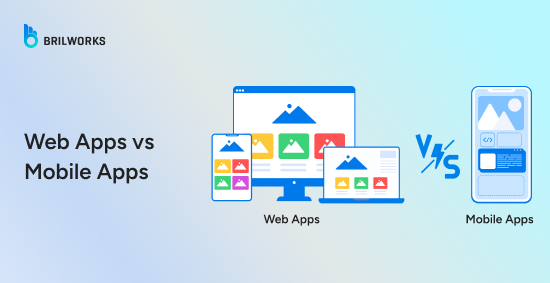
In 2025, saying you're "building an app" is like saying you're "buying a vehicle." Are you buying a sports car, a sedan, or a freight truck? Each one serves a radically different purpose, and choosing the wrong one for your needs can be a costly mistake.
The same is true in the digital world. The app landscape is vast, from the apps you download to the websites you use every day. Apps come in different forms because users have different needs.
There are different needs, and that’s why they come in different shapes, from the mobile apps you download (native) to the web apps you access in your browser (web) and the all-important options in between (hybrid, PWA, cross-platform).
The simple answer: different apps exist to solve different problems on different devices. You use a desktop computer differently than your phone. Deciding which to build is the first strategic decision you'll make.
Let's break down what each path really means for your business, your budget, and your users.
A native mobile app is a program you download and install on your phone from an app store. It's "native" because it's built specifically for a single operating system (like Apple's iOS or Google's Android) in its own native programming language.
You get it by going to the Apple App Store or Google Play Store, searching for the app, and hitting "Download."

A native app's key features all stem from its deep integration with the device. This gives it the highest speed and responsiveness, as the code runs directly on the device's processor. It also has deeper hardware access.
This integration allows for robust offline access, letting the app work perfectly even in "airplane mode." Native apps are also the most reliable for sending instant push notifications and provide the best-in-class user experience (UX) by adhering to the specific design guidelines of iOS or Android, making them feel familiar and intuitive.
Examples: Instagram, Spotify, Google Maps, or any high-performance game you've downloaded to your phone.
A web app is a website that is designed to look and feel like an app. It runs entirely inside your web browser (like Chrome, Safari, or Firefox) and is accessed by typing in a URL or clicking a link. No installation is needed.
These are not simple, static websites. They are powerful applications. The popular example of web app is Google Docs. You don't "install" Google Docs on your laptop, but it's a piece of software that's far more powerful than a simple blog.
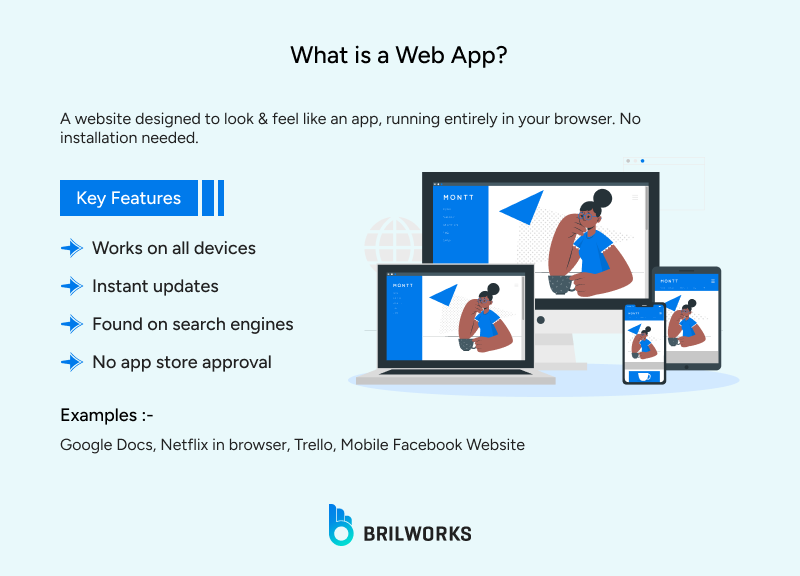
The primary advantages of a web app come from its universal nature. A single codebase functions on all devices, from phones to tablets and desktops. You can push a change at any time, and users get the new version simply by reloading the page, with no "review" process.
Web apps are also easy to find, as they are websites that can be indexed by search engines like Google, which is a massive advantage for SEO.
Moreover, there's no "App Store" tax or approval process. They don't have to go to a store, search, wait for a download, and give up space on their phone.
Examples: Google Docs, Netflix (when you watch in your browser), Trello, or the mobile Facebook website.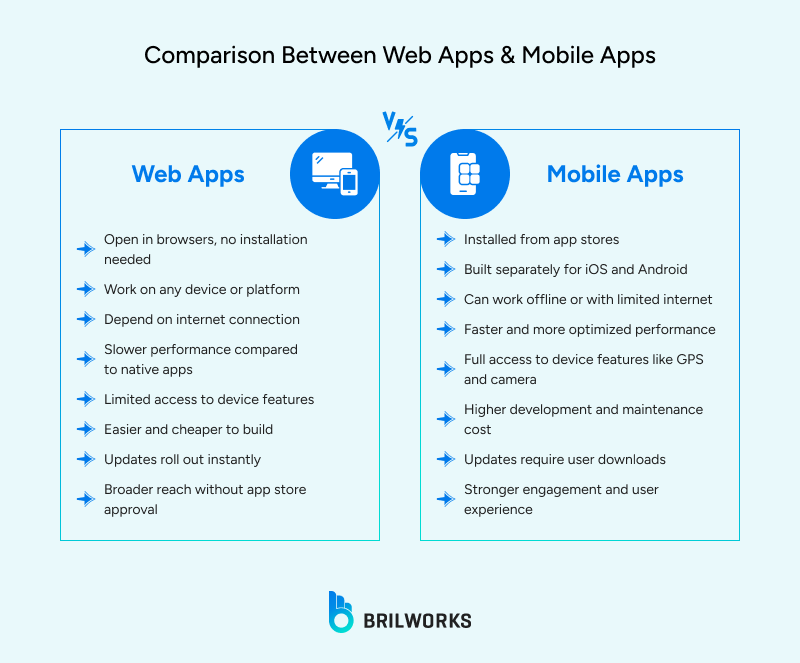
The lines are blurring. The "Web vs. Mobile" debate is no longer black-and-white. Two powerful options exist in the middle, each with its own strategic trade-offs.
This is where the "how" directly impacts your budget and timeline.
You have two main paths to get your app onto a phone.
The first is the native path, which is the traditional way to get the highest performance. This path requires building two separate, high-end products: one for iOS (Apple) using Swift or Objective-C with Xcode, and one for Android (Google) using Kotlin or Java with Android Studio. The major downside is the cost and time, as you must build, update, and maintain two completely separate apps.
The second path is cross-platform, a more efficient "one codebase" method. This is a hugely popular compromise where you write one set of code and export it for both iOS and Android.
The two main frameworks are React Native (from Facebook) or Flutter (from Google). The downside is that it can be slightly less performant than true native for very complex or graphic-intensive tasks.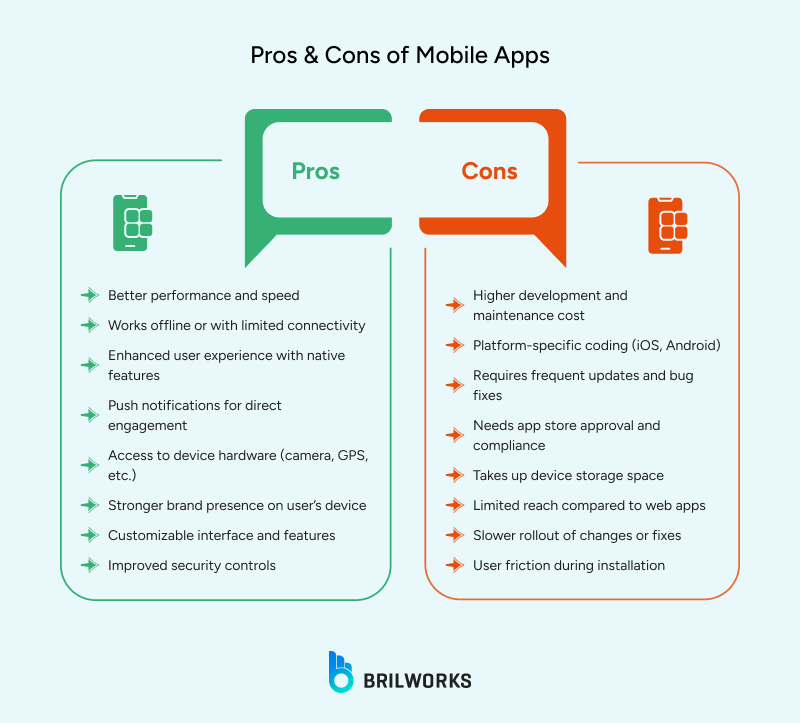
This path is more straightforward and uses one set of technologies.
Every web app uses the same foundation: HTML for structure, CSS for style, and JavaScript for logic and interactivity.
To make the app powerful, fast, and feel like a modern application (and not just a simple webpage), developers use Modern Frameworks. The most popular are React, Angular, and Vue.js. These tools are the building blocks of almost every complex web app you use today.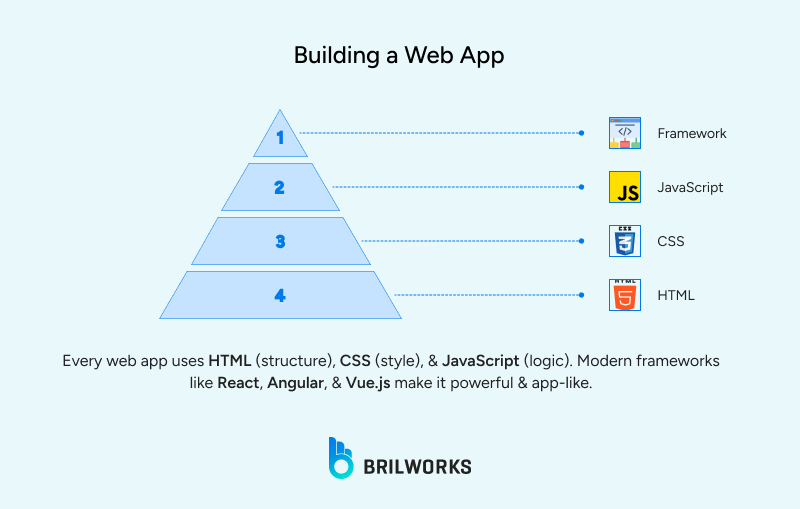
The answer to "which is better?" depends entirely on your project. The following visual comparison and questions will guide you to the right choice.
This question is about user acquisition. If your users will search Google for a solution (e.g., "best budget tracker," "cheap flights to London"), you need a Web App.
Web apps can be indexed by Google, and SEO (Search Engine Optimization) will be your primary way of attracting users.
If your users already know your brand (e.g., you are Starbucks) or your service is built on an existing community, a Mobile App is fine. You will focus on App Store Optimization (ASO) instead of SEO.
Think about your core feature. If it's a 3D game, an augmented reality (AR) tool, a photo editor, or anything that needs complex graphics and raw processing power, you must go Native.
If your app is for reading content, e-commerce, filling out forms, or entering business data, a Web App is faster to build and much easier for users to access.
Be honest about this. If the main feature depends on the advanced camera, background GPS (like a run tracker), Bluetooth to a specific device, or requires shaking the phone (accelerometer), you need a Mobile App.
If you just need basic camera access (to upload a profile picture) or the user's current location (to find stores "near me"), a Web App/PWA can do that.
Here's a simple breakdown:
|
Feature |
Native App |
Web App / PWA |
|
Camera |
Full control (RAW, filters, etc.) |
Basic access (take photo, upload) |
|
GPS |
Full background access (tracking) |
Foreground access ("where am I?") |
|
Push Notifications |
Excellent (iOS & Android) |
Excellent (Android), Limited (iOS) |
|
Offline |
Full, complex logic |
Good (cached content, simple logic) |
|
Bluetooth/NFC |
Excellent, full access |
Very limited or non-existent |
This is often the deciding factor. If you need to launch quickly and on a smaller budget, a Web App is your answer. One codebase works everywhere, making it the definition of a Minimum Viable Product (MVP).
If you are well-funded and can afford the time and cost, a Mobile (Native) app is the most expensive and slowest option, as you are building and maintaining two separate, high-end applications.
Don't forget the hidden cost of maintenance; with a native app, you have two codebases to update, two sets of bugs to fix, and two platforms to test every time you change a feature.
Consider where your users will be. If users must be able to use your app on a plane or subway with zero internet (e.g., a meditation app with audio, a game, a document editor), a Mobile App is the most reliable choice.
If your users just need to read articles or see content they've already loaded, a PWA is a great, lightweight solution for offline caching.
Your development agility is at stake. If you are a startup that needs to be agile, fix bugs instantly, and A/B test features every day, you need a Web App. Updates are instant: you update the server, and everyone has the new version.
If you find a critical, app-breaking bug in your Mobile App, you have to fix it, submit the update to Apple/Google for review (which can take hours or days), and then pray your users download the new version. This is a massive bottleneck.
You should choose a mobile app when you need maximum performance for things like 3D games or AR. It's also the right choice if your core feature depends on specific device hardware, like background GPS or the advanced camera.
Finally, go mobile if you need reliable, complex offline access or if your users are already engaged and will actively search for you in an app store.
A web app is the best choice if you need to launch quickly and on a smaller budget, making it ideal for an MVP. It's the priority if you need maximum reach and to be found on Google (SEO).
This path is perfect if your app is for content, e-commerce, or business data, or if you need to push updates to all users instantly and often. It also lets you avoid the 30% app store revenue cut.
For most new businesses, startups, and ideas, the smartest path is no longer a "web vs. mobile" choice. It's a strategic, phased approach. First, start with a Progressive Web App (PWA). This is the fastest, cheapest, and most versatile way to launch.
Second, build a Native App Later. Once you have a proven product and a dedicated community of users, you can invest the money to build a native app for your "power users"—the 20% of your audience that gives you 80% of your business and who will benefit from the added performance and features. This "Web-First" strategy gives you the best of both worlds: the reach of the web to grow, and the power of native to retain.
Get In Touch
Contact us for your software development requirements
Get In Touch
Contact us for your software development requirements